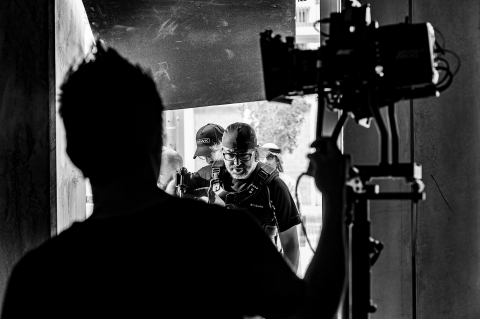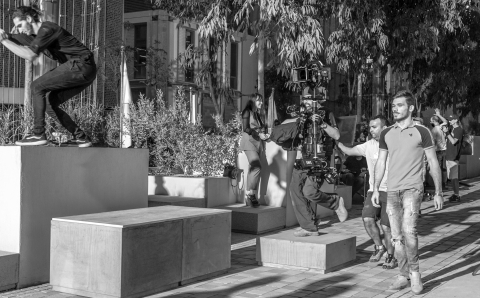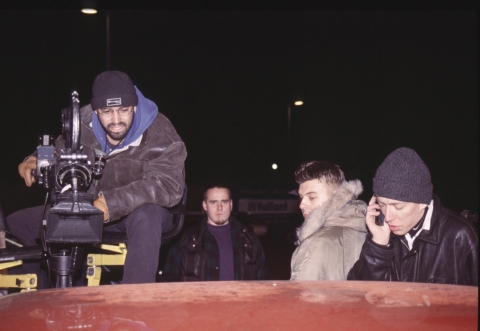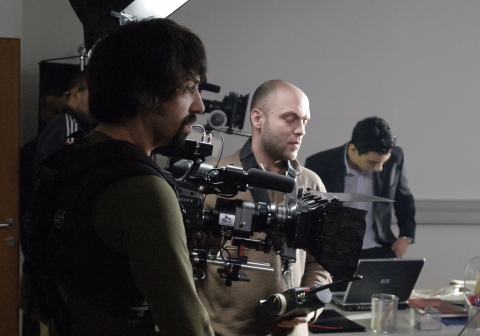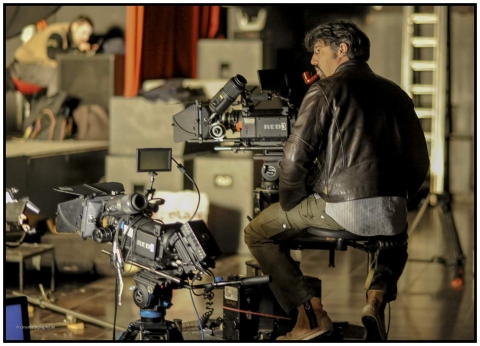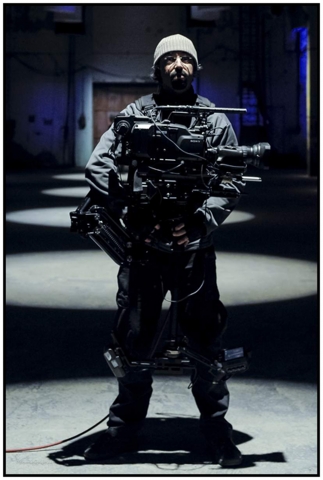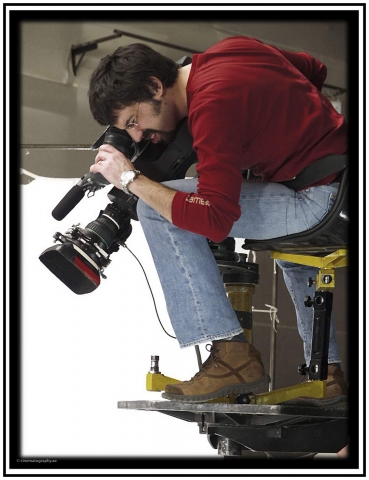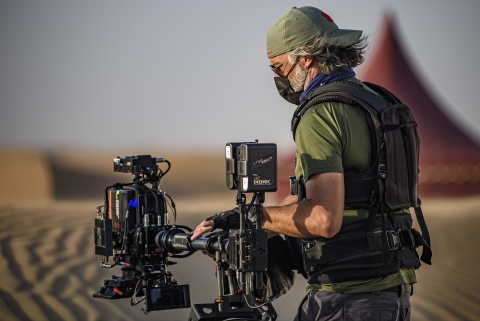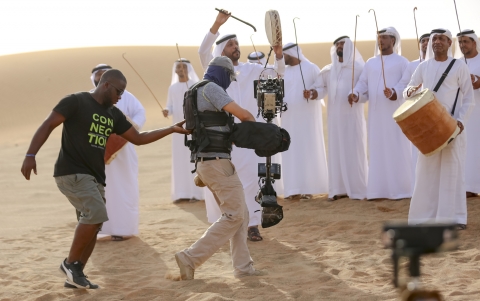Igor Savatovic - StarliteHD, CinemonitorUHD
Mel Noonan interviews Croatian Cinematographer Igor Savatovic
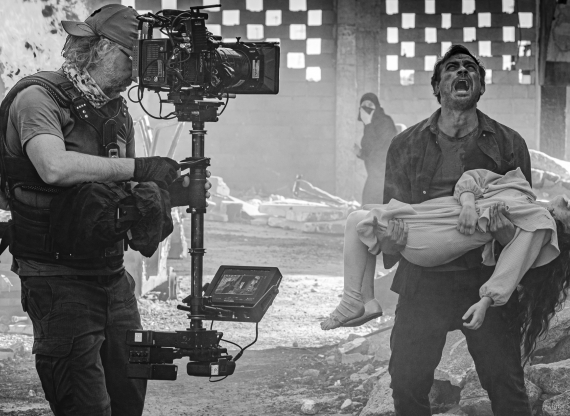
Q: Igor. Looking at the dates corresponding to your growing up and early training in Croatia, there was a war going on - did that play any part in your life at that time?
When war began I was 17 years old, and I was in my graduating year in High School, in my hometown, Pula. Although Pula is known through history as a war harbor and arsenal, it wasn’t affected directly by war. Then I started my Cinematography studies at the Academy of Dramatic Arts in Zagreb in 1994, and Croatia was now at war. It affected all of us directly or indirectly, in my case directly, but not in the way it affected many refugees and the wounded.
In the Spring, on 3rd of May 1995, as the days finally became warmer, usually after lessons finished we used to chill and chat in front of the Academy on comfy benches by the entrance. On that day, after a while I decided it was time to go home. I took the tram towards my student dormitory, but soon after the tram left the station I heard very loud explosions. It was weird. Although Zagreb was quite near the war front line, it was never bombarded. Everyone in the tram looked frightened, but no one had a clue what was happening, but then we were in the middle of a war. When I came to my dormitory I switched the TV on and saw a news item recorded in front of the Academy, which had been hit directly by a cluster bomb, a weapon forbidden by many war conventions. Seconds later I saw my colleagues lifted in to an ambulance. One of them, also on his first year of studies, Film and TV Directing, Luka Skracic, died. It is a weird feeling, when in a circumstances like this, you realize you are the lucky one.
Wikipedia: The Zagreb rocket attacks of May 1995 were a series of two rocket attacks conducted by the Army of the Republic of Serbian Krajina that used multiple rocket launchers to strike the Croatian capital of Zagreb during the Croatian War of Independence. The attack killed seven and wounded over 200 Croatian civilians.
Q: During your childhood and teenage years do you think there was anything that could have led you towards your present career of Cinematographer?
Everything led me to my present career. We had a VHS-C camcorder in the family, and I was obsessed with it. I was always begging my parents to go for a walk so I could take the camera. On the other hand, everyone was telling how good my shots were, although they were complaining that there should be more people, less buildings, flowers and door knobs. :) When I was 15 or 16, I started to shoot weddings and made my first money with the camera. I was also editing them. I had VHS player-recorder with 4 heads, so I could play around with slow motion. You can imagine how slow motion and double copies looked like on VHS at that time. But, not many videographers - I am not even sure that this word existed at that time - were doing this, especially not in a small coastal town in Croatia. Everyone seemed to be impressed by the footage, and I started to have wedding shoots almost every Saturday. Somewhere at that point, my father died. I documented some of the moments during his therapy, and made a film about it. I suppose, when I look at it now, I found some kind of release in filming.
At that point I decided that I would study Cinematography. My mother would have been much happier at that time if I’d chosen Naval Engineering like my father, or any kind of studies not allied to Art, but she gave me absolute and full support. It’s not easy to be accepted into Cinematography studies at the Academy of Dramatic Arts in Zagreb. Only 6 students a year are accepted, so I started my prep two years earlier, because apart from my early experiments I knew little about film and photography, which was crucial for the preliminary acceptance exam. My mother spent a huge amount of money on B&W films and paper that we were buying in nearby Italy (Pula is only 100km from Trieste, Italy). Croatia was at the brink of war at that time, so film and paper were one of the last things for people to be thinking about. I remember once when we were driving from Trieste, at the border the police told us that we had to drive through the night without lights because there was a threat of bombardment. It was a long drive.
It wasn’t easy for my mother, as a single mother living in a country at war, spending this amount of money, abroad, on her son, especially as everyone was saying that I should pull myself together and choose other, more ‘normal’ studies, and that I wouldn’t be accepted at the Academy anyway.
I wasn’t accepted at the Academy the first time, as it happened, so I studied Civil Engineering for two years. It absolutely didn’t work for me. I said to my mother that I will try once more to get in to the Academy. If I don’t get in, I will just come back home and work in the shipyard. I just don’t care about anything else. She wasn’t very happy about my decision, but of course she gave me full support as always. I was accepted this time.
Sadly, she died soon after my graduation.
Photo 3: I have found Trinity to be my ideal tool for running shots. The stabilizing head plus a Transvideo Starlite, a small monitor that doesn’t get in the way, makes it great combination for running shots.
Q: Can you tell us about the experience of doing the University course?
University days were some of the best days in my life. Even if you don’t consider student parties and the fact that I was working as a photographer to support my studies. Working as a photographer was extreme fun for me at the time… it was amazing. It absolutely changed my views and my life. If I hadn’t have gone to University, I would be a completely different person today in a completely different place. I got in touch with people and ideas I couldn’t get in touch any other way. Also I wouldn’t have met my wife if I wasn’t at the Zagreb University.
For the first year at the Academy, we weren’t allowed to touch a film camera or color film. All the exercises were based on photography and black and white film. I think this is a great approach. Actually it is so hard for someone to start thinking through contrast, framing, focal lengths; to understand which light to use to make ‘a face look like a face’; how to use contrast to express emotion; how to mimic and learn from paintings by the Old Masters. This is actually amazingly hard with film, film developers and of course the approach through film media. We as humans, especially now in the digital era, think that filming is something natural, and easy, and we can do it because we see it! Yes, we can take a picture, but to create a deliberate, exact emotion you want in a viewer, is very difficult. It takes a lot of training. Not only in film, but also in art history, and somehow psychology, especially when we get into color film. I remember one day Prof. Tadic was screening ‘The Third Man’ in our school cinema. Suddenly, he stops the film, and he turns towards the students.. ‘Do you know who you are? You are little Gods. You are playing with peoples’ emotions’. It took me some time to get this, but this was the approach we had from our Professors at the Academy. It wasn’t only about the craft, it was also about the art. At the beginning, I dismissed their approach. I wanted to work in a big film industry. Shoot big budget films. Now, some 30 years later, I am very thankful and happy that I apply their approach to film. If you have the knowledge and understanding about film and if you really want and you are really ready to sacrifice a lot, you can end up in big budget films, especially in some of the camera crew jobs. It’s up to you to decide is it worth it.
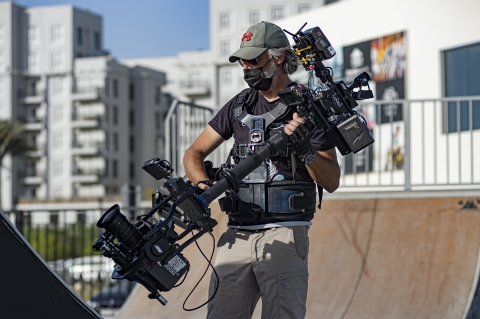
Photo 4: One of the most recent commercials I shot with Trinity, for Russian energy drink ‘Flash’ in 2021. The clients were in Russia, and we were shooting in Dubai. All the input from their side was coming in real time through a live broadcast of the shoot. It is amazing how nowadays, when our world changes practically overnight due to Corona virus, how filmmakers are adapting to new situations.
Q: You mentioned attending the Imaginary Academy whilst at University. What is that? What was the experience?
The Imaginary Academy is in Groznjan, Croatia, and it was a wonderful experience. I went to their Documentary Workshop, which was not only an excellent course but included great dinners after the lectures, accompanied by further good discussion, and I must say amazing wine. That part of Croatia, Istria, is famous for its wines. Thanks to that workshop, I came to shoot 3 documentaries, and after that, for few years, I dedicated myself to making documentary films. Thanks to those documentaries I was accepted into the Croatian Freelance Artists Association. Even today, it sounds funny to me when someone says ‘I am a Freelance Artist’. In Croatia, you need a decree from Minister of Culture to become one. But, every country has its own ways and rules. So yes, after the Academy of Dramatic Arts, and Imaginary Academy, I can say that my professional career in film started.
Q: What was the experience of starting to work as a DOP?
I started to work as DOP, or better said cinematographer, while I was still a student. I prefer cinematographer, because ’Director of Photography’ has become very much abused these days. The thing is that many people involved in film or video productions today are unaware of film terminology, and they are using it in a completely wrong way. I believe that DOP is the most misused one. Anyway, I mostly shot music videos and low budget commercials. They were mostly done on Betacam, but there were some on 16mm film from time to time. I also worked as cameraman on sporting events and live TV shows. Honestly, some of them I don’t remember, and some of them are not worth remembering, but all of them were great experience.
Photo 5: ‘The Death of the Seals’ shot in 1998, with an ARRI BL 16 camera. On the phone is the esteemed Croatian Director of today, Ivan Goran Vitez. For both of us, this was graduating film at the Academy of Dramatic Arts.
Q: What about your getting into Stabilizer type work. How did that come about?
I got into Stabilizer work after my graduation. I was always fascinated with camera moves. I was always thinking about dolly, crane, Steadicam moves in my shots, but since all I shot at that time was low budget production, we could rarely afford to rent a rig. Actually, I never had a Steadicam® type rig on my shoots before I bought one. So, I used hand held, but mainly I preferred legs, because I really liked and I still do, shots that are controlled and without shakes.
At that point the DVcam revolution started. Everyone was buying DVcam cameras. Productions became cheaper and there was more work. I was thinking about buying a DVcam camera, but there were a lot of them on the market, so it didn’t make too much sense. At that time there were, if I remember correctly, only two Steadicam type rigs in Croatia, and both of them were for film cameras. DVcams were too light for them, and you couldn’t balance them without proper weight underneath the camera, and on the other hand, they were too expensive to rent for DVcam productions anyway. At that point I started to think about a Steadicam type rig that could be used with DVcam cameras. I was doing my research on that for a while, mainly on line. I was reading everything relevant I could, and saving on my computer any photo I found of any Steadicam operator and their rig. The only problem I had was I couldn’t afford one.
So for a while, I was still working as Cinematographer, spending nights on a computer on the Steadicam forum, consequently waking up my then girlfriend in the middle of the night, my wife Zrinka today. It finally happened for me due to one quite sad event that at the end turned out well. Zrinka and I were on a holiday. We had a car accident and unfortunately she was injured. We came back home, fortunately she recovered quite fast, and she was recompensed from the insurance for her injury. Her idea was to buy a Steadicam type rig. She knew how much I loved it, and that I would like to point my career in the direction of Steadicam operator. So in 2001, I bought my first stabiliser type rig, a Glidecam V-16. And it was a mess! We spent all the money we had on something, that couldn’t even be statically balanced properly. Honestly, after couple of days I was in my storage room and after hours spent on balancing the rig without any progress, I was moved to tears. The problem was solved by the great Steadicam community. I posted my issue on the Steadicam forum, and if I remember correctly, Jamie Silverstein told me the answer to my problems! So once again, thank you Jamie!
After solving this issue and making the rig useable, I had only two or three jobs during that first year. It was absolutely depressing. We were living in one room because we couldn’t afford to pay the heating for the bedroom. I was offered jobs without the rig, but Zrinka told me to wait and not to accept those jobs because we’d invested in the Glidecam. Things will work out – and as always, she was right!Somehow, I’m still not sure how things worked out for both of us, but they did. Zrinka graduated from medical school and started her successful career as a Doctor. I got more and more work - my first contract as Steadicam operator was for the ‘Big Brother Live TV show. And yes, we got married.
Photo 6: Crime TV Series, ‘Conspiracy’ - 2006. This TV series really gave me boost in my future work. It was shot all over ex-Yugoslavia.
Q: In the years before and after graduation, were there cinematographers or movies in particular that inspired you?
I was always a very big fan of Martin Scorsese. I still get goose bumps when I think of that Taxi Driver final shot through the ceiling. I remember I watched Goodfellas on a weekly basis. Of course there is ‘The Copacabana Shot’ probably one of the best Steadicam moves in the history of film. Shot by amazing operator Larry McConkey. Even PhDs were written about that shot, which I believe radically changed the thinking about Steadicam. I believe that somewhere at that point directors started to approach Steadicam operators and ask for input regarding that particular shot, which at that time, without Steadicam, was impossible. Scorsese was also one of the first who was successful using contemporary rock music as a soundtrack for his scenes. I found this part very important for our generation to get into the mood of the scene. There is also Brian De Palma’s Snake Eyes, featuring again, Larry McConkey - one of best film openings ever. I was always playing those to my Steadicam lecturers. There is David Fincher’s Seven. I went to see it 3 times in a row. I just couldn’t believe the darkness, the mood that cinematographer Darius Khondji managed to achieve with, at that point the quite revolutionary ‘bleach bypass’.
We should always keep in mind that those films were shot on film. Today, all this is much easier to achieve with digital cameras. I believe that film shouldn’t be ‘victimized’ by cinematography. There is a story, there are actors, there is editing, there are film sets and costumes, and cinematography has to adapt to all of them in the same way that all those elements should adapt to cinematography. It is all about compromise at the end. Sometimes it is hard for us to remember that at the end a film is a product, an expensive one, and we are not doing it for ourselves and the film community, but for the audience. This is a subject in itself. It is very complex to talk about where art should stop and then allow compromise so that craft can take over.
Photo 7: Documentary TV series ‘Battle for Vukovar’. Many years after the Croatian Independence War ended we wanted to give the final answer as to what happened in Vukovar during the siege of the town. Hundreds of survivors, politicians and soldiers were interviewed, and never seen before footage was included in the series. – 2011.
Q: Regarding your move to the UAE, what brought that about, and when was it? Is life there different to what you were used to in Croatia? Are there advantages, disadvantages?
I moved to UAE in 2013 and this happened by pure coincidence. I had considerable experience as DOP in shooting TV series. MBC was shooting their first 120 episodes of a TV series, and they invited me to be a DOP on it. My contract was renewed several times and I shot 3 TV series for MBC production. In the meantime my wife and our 4 dogs also moved to Dubai. She started her career here and, we decided to make Dubai our home. Now I am working as a freelance cinematographer and Steadicam operator.
UAE is very different compared to Croatia. First of all the climate is very different and very harsh. It affects people and equipment during a shoot. The approach to solving problems in any aspect of daily life is different. However, the approach to solving problems in the film industry all over the world is the same. Professional filmmakers speak a universal language, so it wasn’t hard at all to adapt to work in Dubai. We both assimilated to the way of life here, and we find our life in Dubai very pleasant.
Photo 8: One of the seasons of Realty show ‘Master Chef’, shot in old abandoned factory as a set. Temperatures were freezing, which was very exhausting for the candidates and for the crew, but the set looked amazing.
Q: I’m guessing that to make the decision to buy the ARRI Trinity was quite a big step. What was the deciding factor? What’s your experience in using it?
Buying Trinity was somehow a natural step for me. I have been a Steadicam operator now for 20 years and I really love my job. Every job after this amount of experience becomes a routine, an instinct. There are shoots that are more demanding, and this is something that makes you want to keep going on, but I really needed some kind of, let’s call it.. a thrill.
I have known Curt Schaller, developer of the Artemis stabilizer rig, for 15 years. I had two Artemis rigs, and during those 15 years Artemis changed a lot. Curt is one of the most productive innovators in the world of stabilizers. Through this time, I can say we became friends. Although, I am not big fan of gimbals, we were talking about gimbals that you can use in a similar way to stabilizers. At that point it looked to me to be a tool made to help inexperienced operators to maintain a level horizon. He suggested I ‘check this out’ and sent me videos of the Trinity prototype. The idea that you can boom with the stabilizer, that you can do whip pans extremely fast and extremely stable (‘Snake eyes’ Larry McConkey influence :)); that you can shoot around the corner, were very appealing to me, but it was still a prototype. Then Trinity came in to production, first through Sachtler, and then ARRI. Since I never buy anything without trying it, I waited until a demo rig came to Dubai. I tried it, and I was a little bit disappointed. I managed to do some things, but I decided to not go with it at that time. I was still very interested, because idea of a stabilizer like this, made by reputable manufacturer, was very appealing. I was watching a lot of Trinity videos on YouTube, and these videos were amazing. Some shots couldn’t be done with anything else. And again, talking with Curt about it, I decided to go for it. At the end, he is never wrong about stabilizers. I bought the Arri Trinity.
Buying it turned out to be the easiest part. It was quite complicated to learn and get acquainted with it. It is very different from a traditional rig. Different muscles are working, different kinds of balancing, prep of the camera, and most of all different approach to the shot. Directors and DOPs at that point, since Trinity was quite a new tool, weren’t completely familiar with the possibilities of it. It was and still is, very important to have a recce before the shot, so director, DOP, can pull the maximum from it. At the end everything worked like a dream - an amazing tool with amazing possibilities. With good prep you can pull shots that you were not able to do with any other stabilizer You can even use it for locked off camera shots. It is not a Technocrane, but sometimes in conjunction with a rickshaw, we are using it instead of a Technocrane. That makes producers very happy.
All in all, great tool with great possibilities if you have a right approach to it.
Photo 9: One of the shoots from beginning of my career, when I was mostly working as cinematographer on music videos and low budget commercials.
Q: Looking back over your career, over 20 years on since graduation, are there jobs in particular that stand out for you?
This is very tricky question. I am asked this a lot. Honestly at this point, a lot of things come to mind. The TV series at MBC, the TV series back home. Some commercials, music videos, live TV shows… But the things I remember the most are the people I was with on set, and the mood we had when doing it. When we are together we never talk about how good something was, or what the ratings were. We always talk about what was happening behind the camera.
Q: You have done a lot of television work. Did you develop your own style for shooting this?
Yes, I did, I really developed a kind of style for live TV. It took me several years and I have to mention here the director I was working the most, Mario Vidosavljevic. Of course there was the whole crew behind the camera, and a production team which had an understanding for our demands. We were going from one production to another. We were discussing the shots on preps, before the set was built, before the lighting design, and of course before the rehearsals. We were watching a lot of live TV shows. The live show that influenced us the most was Eurovision. Steadicam work on Eurovision was second to none. We were trying to implement this kind of camera work in to our shows, but our circumstances were far from those on Eurovision. To have good Steadicam moves that made sense took collaboration from the whole team. Director, director’s assistant, switcher and camera operators, producers, lighting designers, and very important, set designers, and yes, I had this. So thank you all back home. I miss you!
I loved live TV shows and I am missing those here in Dubai. Unfortunately, due to language barriers, and a different approach to live TV here, this kind of work never worked properly for me in Dubai.
Photo 10: Music video for Indian star, Rider, directed by Gil Green. Lately my rig is equipped with two Transvideo monitors, a Starlite, under the camera, used mainly as a recorder, and my Transvideo CineMonitor HD8” XSBL. It’s brighter and bigger. Starlite is great for Trinity, because of its size and weight. The option to record the shots is amazing, because I can always check my work between takes.
Q: Jacques Delacoux of Transvideo says that he has known you for many years. How is it that you met?
I met Jacques at the beginning of my career. When I bought my Glidecam V16, it came with a really bad LCD monitor. I really wasn’t able to operate properly with a monitor like that. I couldn’t see the picture on a bright day. And again, through the internet I found that the brightest monitors were, and still are, Transvideo monitors. I sent an email to Transvideo, and Jacques replied immediately. So, again, same story like the one with Glidecam. I couldn’t afford the Transvideo at that time. I didn’t want any other monitor, because, one bad monitor is more than enough. So I waited. I waited until my wedding. I got my first Transvideo monitor as wedding present from my wife. It was a Rainbow 6”, and of course I still have it today and it still works like the first day. The only thing was I didn’t have a proper bracket to attach it to my rig. When I went to IBC, I went to the Transvideo booth, met Jacques, and he actually remembered me. After telling him about the mounting issues, he told me that when he returned to France he would send me a ball mount for it. And he did! I wasn’t really expecting this. You cannot find many owners of companies that think about the newbie operator, and are willing to send parts for free! After that, every monitor I had was a Transvideo. I have 5 Transvideo monitors today, and all of them are working like they did the first day. You should be aware that I live in desert climate, with sand and temperatures rising to 50C. The highest temperature I experienced working with my Transvideo on my rig was 45C. Other LCD monitors were dying on set, but thankfully not my Transvideo. There were issues with one monitor of mine. Many years ago, after I fell with the Steadicam, one CineMonitor III didn’t work anymore. Jacques personally responded to my email, and told me how to solve the issue. Most of manufacturers will tell you to send the equipment to the factory for a service. Well Transvideo is not like most manufacturers.
To this day I am still in contact with Jacques, and from my experience Jacques is one of the rare people in the film equipment industry that is really trying to help small customers, freelancers like me - before the sale, and after the sale, even when the warranty of the product expires. For the Steadicam operator, his rig is as important as his house or his car. My rig is paying for all of this, and it should be always in perfect condition. Jacques is aware of this.
Photo 11: Commercial, shot in summer in the desert. I was still using my CineMonitor III. I had it for 15 years, and I never wanted it to change it. I changed it for an HD8” XSBL because I wanted a slightly larger screen, still the brightest monitor in the marketplace.
Q: You seem to have made a very good path to where you are now in your career. Do you have any further ambitions for the period ahead?
There are always certain plans, certain ambitions. If you stop going forward, you start to move backwards. Honestly I don’t know where my career will take me. There is always something going on. Steadicam, Trinity, cinematography, teaching from time to time. Constant reading, constant film watching. Honestly I cannot predict where this will take me. I just hope I will be able to work until my old age. I can’t imagine my life without cinematography,… and without music and my vinyl record collection. :)
Q: Perhaps a closing word on your career or advice to those starting out?
I don’t think I’m the right person to give advice. I have made a lot of mistakes in my career, and I think that was part of the process. There have been a lot of compromises along the way, but one thing does seem to be constant, the will to pursue the dream. But you need to add to that first class training and a lot of hard work. A little bit of talent comes in handy too!
For me, the most important thing that I found in my career was my wife’s support. Without her I absolutely wouldn’t be the person and cinematographer I am today.
Igor Savatovic, SOA
Director of Photography / Steadicam - ARRI Trinity operator
www.igorsavatovic.com
Steadicam® is a registered trade mark of The Tiffen Company

